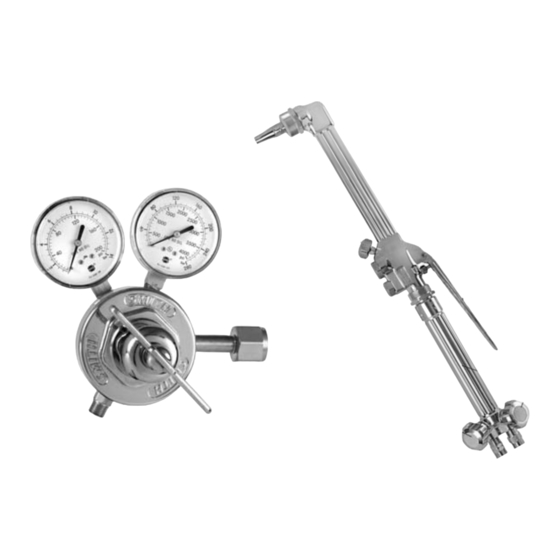Miller OM-262 659C Panduan Keselamatan - Halaman 7
Jelajahi secara online atau unduh pdf Panduan Keselamatan untuk Sistem Pengelasan Miller OM-262 659C. Miller OM-262 659C 46 halaman.

D
Wear body protection made from durable, flame−resistant material
(leather, heavy cotton, wool). Body protection includes oil-free
clothing such as leather gloves, heavy shirt, cuffless trousers, high
shoes, and a cap.
D
Do not use fuel gases to clean clothes or work area.
D
Remove any combustibles, such as a butane lighter or matches,
from your person before doing any welding or cutting.
D
After completion of work, inspect area to ensure it is free of sparks,
glowing embers, and flames.
D
Follow requirements in OSHA 1910.252 (a) (2) (iv) and NFPA 51B
for hot work and have a fire watcher and extinguisher nearby.
CYLINDERS can explode if damaged.
Compressed gas cylinders contain gas under high pressure. If
damaged, a cylinder can explode. Since gas cylinders are normally part
of the welding or cutting process, be sure to treat them carefully.
D
Protect compressed gas cylinders from excessive heat, mechani-
cal shocks, physical damage, slag, open flames, and sparks.
D
Install cylinders in an upright position by securing to a stationary
support or cylinder rack to prevent falling or tipping. Do not lay acet-
ylene cylinders on their sides or acetone will flow out of the cylinder
and damage the equipment.
D
Keep cylinders away from any arc welding, cutting, or other electri-
cal circuits.
D
Never drape a welding or cutting torch over a gas cylinder.
D
Never weld or cut on a pressurized cylinder − explosion will result.
D
Use only correct compressed gas cylinders, regulators, hoses, and
fittings designed for the specific application; maintain them and as-
sociated parts in good condition. Do not use compressed gas cylin-
der unless an approved gas regulator is attached to the gas valve.
D
Turn face away from valve outlet when opening cylinder valve. Do
not stand in front of or behind the regulator when opening the valve.
D
Keep protective cap in place over valve except when cylinder is in
use or connected for use.
D
Use the right equipment, correct procedures, and sufficient num-
ber of persons to lift and move cylinders.
D
Store compressed gas and oxygen cylinders in separate locations.
D
Store empty cylinders with valves closed and caps in place.
D
Do not modify or repair cylinders or valves. Store leaking acetylene
cylinders outdoors in a safe area. Identify leaking cylinders and re-
turn them to the supplier.
D
Dispose of used disposable cylinders according to the manufactur-
er's recommendations. Do not throw cylinders in fire.
D
Follow instructions provided by the gas supplier and on com-
pressed gas cylinders, associated equipment, and in Compressed
Gas Association (CGA) publication P-1 listed in Safety Standards.
FLYING METAL or DIRT can injure eyes.
S
Welding, cutting, chipping, wire brushing, and grinding cause
sparks and flying metal.
S
Wear welding goggles, or wear welding helmet/welding face-
shield over approved goggles/safety glasses with side shields.
OM-262 659 Page 5
